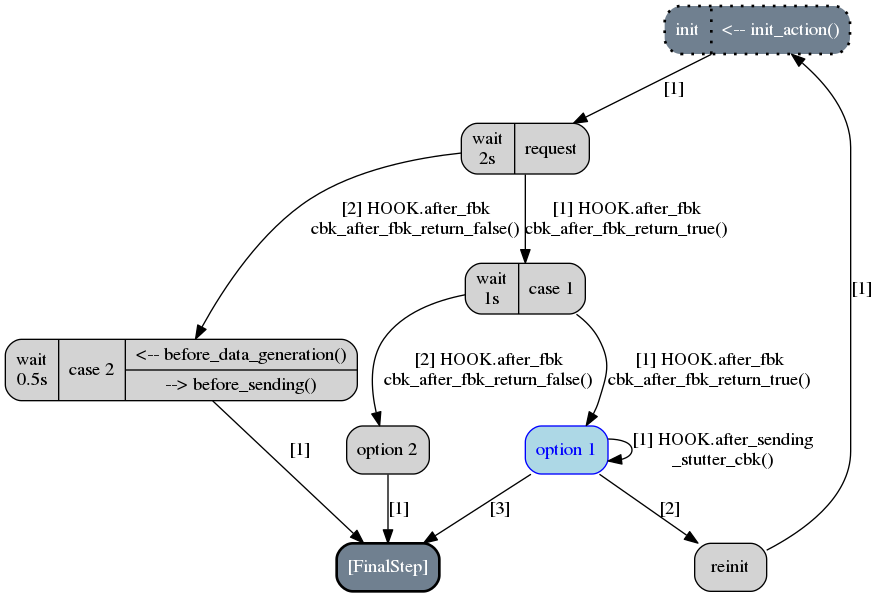6. Scenario Infrastructure¶
6.1. Overview¶
The Scenario Infrastructure enables you to describe protocols which are based on the data described in a data model. You can do whatever you want, either by following a standard or playing around it.
Once a scenario has been defined and registered (refer to Scenario Description),
Fuddly will automatically create a specific Generator that comply to what you described.
Note
The Fuddly shell command show_dmaker_types displays all the data maker,
Generators and Disruptors. The Generators which are backed by a scenario are prefixed by
SC_.
A scenario is a state-machine. Its description follows an oriented graph where the nodes, called steps, define the data to be sent to the target. The transitions that interconnect these steps can be guarded by different kinds of callbacks that trigger at different moment (e.g., after sending the data, or after having retrieved any feedback from the target or any probes registered to monitor the target).
Finally, once a scenario has been described, some automatic alterations can be performed on it. It is especially useful in the case of protocol fuzzing to assess the robustness of the target regarding protocol sequencing, timing, and so on. This is described in the section Scenario Fuzzing.
6.2. Scenario Description¶
6.2.1. A First Example¶
Let’s begin with a simple example that interconnect 3 steps in a loop without any callback.
Note
All the examples (or similar ones) of this chapter are provided in the file
<fuddly_root>/data_models/tutorial/tuto_strategy.py.
1 from framework.tactics_helpers import Tactics
2 from framework.scenario import *
3
4 tactics = Tactics()
5
6 periodic1 = Periodic(Data('Periodic (5s)\n'), period=5)
7 periodic2 = Periodic(Data('One Shot\n'), period=None)
8
9 step1 = Step('exist_cond', fbk_timeout=1, set_periodic=[periodic1, periodic2],
10 do_before_sending=before_sending_cbk, vtg_ids=0)
11 step2 = Step('separator', fbk_timeout=2, clear_periodic=[periodic1], vtg_ids=1)
12 step3 = NoDataStep(clear_periodic=[periodic2])
13 step4 = Step('off_gen', fbk_timeout=0)
14
15 step1.connect_to(step2)
16 step2.connect_to(step3, cbk_after_fbk=check_answer)
17 step3.connect_to(step4)
18 step4.connect_to(step1, cbk_after_sending=check_switch)
19
20 sc1 = Scenario('ex1', anchor=step1, user_context=UI(switch=False))
21
22 tactics.register_scenarios(sc1)
Note that scenarios can be described:
either in a
*_strategy.pyfile that matches the data model you base your scenarios on;or in a project file, if your scenarios use different data models involved in your project or the scenarios are agnostic to any data model but have a meaning only at project level.
In what follows we illustrate how to describe scenarios in the context of the data model mydf defined in
tuto.py (refer to Defining the Imaginary MyDF Data Model for further explanation on file organization). Describing scenarios
in the context of a project will be the same except for the scenarios registration step, where the method
framework.project.Project.register_scenarios() will have to be used to make them
available within the framework.
In our example, the registration goes through the special object tactics (line 4) of tuto_strategy.py
which is usually used to register the data makers (disruptors or
generators) specific to a data model (refer to Defining Specific Disruptors for details), but also used
to register scenarios as shown in line 20.
From line 9 to 13 we define 4 framework.scenario.Step:
The first one commands the framework to send a data of type
exist_cond(which is the name of a data registered in the data modelmydf) as well as starting 2 periodic tasks (threaded entities of the framework) that will emit each one a specific data. The first one will send the specified string every 5 seconds while the other one will send another string only once. Additionaly, the callbackbefore_sending_cbkis set and will be triggered when the framework will reach this step (callbacks are discussed in a later section). Note that the step sets also the maximum time duration thatFuddlyshould respect for collecting the feedback from the target (feedback timeout). This timeout is actually handled by theTargetobject, which may decide to respect it or not. For instance theNetworkTargetrespect it while theEmptyTarget(default target) do not. Note that the feedback mode (refer to Generic Targets) is also supported and can be set through the parameterfbk_mode. Finally, the parametervtg_idsis used to allows interacting in a multi-targets environment (this topic is detailed in Scenario Involving Multiple Targets). In this case it asks to send the data to the target referenced by the virtual ID 0.The second step commands the framework to send a data of type
separatorand change the feedback timeout to 2. Additionally, it requests the framework to stop the first periodic task, and asks it to send its data to the target referenced by the virtual ID 1.The third step do nothing except requesting the framework to stop the second periodic task.
The fourth step requests to send a data of type
off_genand change back the feedback timeout to 0. Additionally it commands the framework to stop the periodic task which is currently running.
Note
The feedback timeout will directly influence the time that seperates the execution of each step
The linking of these steps is carried out from the line 15 to 18. Some callbacks are defined and are
explained in a later section. Then in line 20,
a framework.scenario.Scenario object is created with the name ex1 which is used by Fuddly
for naming the generator that implements this scenario. It prefixes it with the string SC_ leading to
the name SC_EX1. The scenario is then linked to the initial step in line 18.
Note
The user_context parameter of the Scenario class used in line 20 allows to provide parameters
to Steps and callbacks of
the scenario (through the ScenarioEnv object shared between them and described in a later section).
This parameter can be filled with any object. Anyway, the preferable object class to use is
framework.global_resources.UI which is the container class also used to pass parameters
to Generators and Disruptors.
The execution of this scenario will follow the pattern:
step1 --------------------> step2 ---------> step3 -------> step1 ---------> ...
| | | |
\--> periodic1 ... [periodic1 stopped] | \--> periodic1 ...
\--> periodic2 ... [periodic2 stopped] \--> periodic2 ...
You can play with this scenario by loading the tuto project with the TestTarget 7 and 8 (useful
to provide arbitrary feedback):
[fuddly term]>> run_project tuto 7 8
[fuddly term]>> send_loop 10 SC_EX1
If you want to visualize your scenario, you can issue the following command
([FMT] is optional and can be xdot, pdf, png, …):
[fuddly term]>> show_scenario SC_EX1 [FMT]
If you want to monitor the current step of the scenario each time you trigger the generator that runs
through it, you have to set the generic parameter graph to True. Then, each time you trigger
the generator the current step will be shown in blue:
[fuddly term]>> send SC_EX1(graph=True:graph_format=xdot)
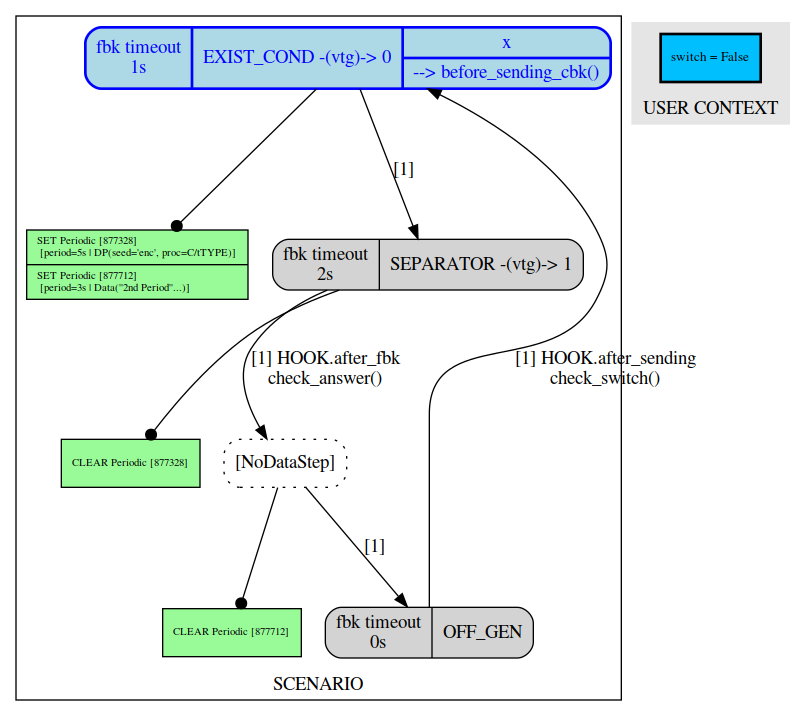
Then after another call:
[fuddly term]>> send SC_EX1(graph=True:graph_format=xdot)

Note
All available parameters can be consulted by issuing the following command (like any data generators):
[fuddly term]>> show_generators SC_EX1
6.2.2. Steps¶
The main objective of a framework.scenario.Step is to command the generation and sending
of one or multiple data to targets selected in the framework. The data generation depends on
what has been provided to the parameter data_desc of a framework.scenario.Step. This
is described in the section Data Generation Process.
Note that the data generated in one step will be sent by default to the first loaded target. If the
scenario you describe involve different targets, you could then refer to them by specifying virtual
target IDs in the step constructor thanks to the parameter vtg_ids. Virtual target IDs are then
to be mapped to real targets within the project file. Refer to Scenario Involving Multiple Targets.
A step can also modify the way the feedback is handled after the data have been emitted by the
framework. The parameters fbk_timeout, and fbk_mode (refer to Generic Targets) are used
for such purpose and are applied to the current target (by the framework) when the step is reached.
A step can additionally triggers the execution of periodic tasks that will emit some user-specified
data (note the execution will trigger after feedback retrieval from the framework). This is done by
providing a list of framework.scenario.Periodic
to the parameter set_periodic. And, in order to stop previously started periodic tasks,
the parameter clear_periodic have to be filled with a list of references on the relevant
periodic tasks.
See also
Refer to the section A First Example for practical information on how to use such features.
A step can also start a periodic or a one-shot task whose content could be entirely specified by
the user. This is done by providing a list of libs.utils.Task
to the parameter start_tasks. And, in order to stop previously started periodic tasks,
the parameter stop_tasks have to be filled with a list of references on the relevant
periodic tasks. Details on tasks are provided here Defining Tasks.
In addition to the features provided by a step, some user-defined callbacks can be associated to a step and executed while the framework is handling the step (that is generating data as specified by the step and sending it):
If some code need to be executed when a step is reached and before any data is processed from it, you can leverage the parameter
do_before_data_processingof theframework.scenario.Stepclass. It has to be provided with a function satisfying the following signature:1 def before_data_generation_cbk(env, step)
where
stepis a reference to theframework.scenario.Stepon which the action is executed, andenvis a reference to the scenario environmentframework.scenario.ScenarioEnv.And if some code need to be executed within a step after data has been processed and just before its sending, you can leverage the parameter
do_before_sendingof theframework.scenario.Stepclass. It has to be provided with a function satisfying the following signature:1def before_sending_cbk(env, step)
where the parameters have the same meaning as previously.
Note also that a step once executed will display a description related to what it did. You can override
this description by providing the step_desc parameter of a framework.scenario.Step
constructor with a python string.
Finally, some subclasses of framework.scenario.Step have been defined to make a scenario description
easier:
framework.scenario.FinalStep: When such kind of step is reached, it terminates the execution of the scenario. It is equivalent to aStepwith itsfinalattribute set toTrue.framework.scenario.NoDataStep: This kind of step should be used when the purpose is not to generate and send data but only to use other step features (e.g., feedback timeout or mode). Besides, the step callbackdo_before_data_processingwill still be triggered if some code need to be executed (butdo_before_sendingwill not). And all the transitions from this step would only trigger their callbackcbk_after_fbkto evaluate their condition.
6.2.3. Transitions¶
When two steps are connected together thanks to the method framework.scenario.Step.connect_to()
some callbacks can be specified to perform any user-relevant action before crossing the
transition that links up the two steps, but also to decide if this transition can be crossed.
They act as transition conditions.
Indeed, a callback has to return True if it wants the framework to cross the transition, otherwise it should return False. If no callback is defined the transition is considered to be not guarded and thus can be crossed without restriction. Besides, only one transition is chosen at each step. It is the first one, by order of registration, that can be activated (at least one callback that returns True, or no callback at all). It is worth noting that the transitions are executed in a minimalistic way, meaning that if a callback return True, the associated transition will be chosen and no other callback will be executed (except all the callbacks from the selected transition) before a next step need to be selected.
Two types of callback can be associated to a transition through the parameters
cbk_after_sending and cbk_after_fbk of the method framework.scenario.Step.connect_to().
A brief explanation is provided below:
cbk_after_sendingTo provide a function that will be executed before the execution of the next step, and just after the sending of the data from the current step. Its signature is as follows:
def callback(scenario_env, current_step, next_step)
The
current_stepis the one that is in progress and which is connected tonext_stepby the transition containing the current callback. Thescenario_envparameter is a reference to the scenario environmentframework.scenario.ScenarioEnv, which is shared between all the steps and transitions of a scenario.Note
A scenario environment
framework.scenario.ScenarioEnvprovides some information like an attributedmwhich is initialized with theframework.data_model.DataModelrelated to the scenario; or an attributetargetwhich is initialized with the current target in use (a subclass offramework.target.Target).A scenario environment can also be used as a shared memory for all the steps and transitions of a scenario.
cbk_after_fbkTo provide a function that will be executed before the execution of the next step, and just after
Fuddlyretrieved the feedback of the target (and/or any registered probes). Its signature is as follows:def callback(scenario_env, current_step, next_step, feedback)
This type of callback takes the additional parameter
feedbackfilled by the framework with the target and/or probes feedback further to the current step data sending. It is an objectframework.database.FeedbackGatethat provides the handful methodframework.database.FeedbackGate.iter_entries()which returns a generator that iterates over:all the feedback entries associated to a specific feedback
sourceprovided as a parameter—and for each entry the triplet(status, timestamp, content)is provided;all the feedback entries if the
sourceparameter isNone—and for each entry the 4-uplet(source, status, timestamp, content)is provided. Note that for such kind of iteration, theframework.database.FeedbackGateobject can also be directly used as an iterator—avoiding a call toframework.database.FeedbackGate.iter_entries().
This object can also be tested as a boolean object, returning False if there is no feedback at all.
Note that a callback can modify a step. For instance, considering an imaginary protocol, and after sending a registration request to a network service (initial step), feedback from the target are provided to the callbacks registered on the next transitions. These callbacks could then look for an identifier within the feedback and then update the next step to make it sending a message with the right identifier.
A step has a property node that provides the root node (framework.node.Node)
of the modeled data it contains or None if the data associated to the step is a raw data
(like Data('raw data')). Any callback can then alter the node of a step in order to update it
with usefull information. In our example, the node is updated with the identifier (refer to
line 10-11 of the following code snippet).
Note
Accessing to next_step.content from a callback will provide None in the case the next
step include a raw data. In the case it includes a DataProcess, next_step.content will
provide the framework.node.Node corresponding to the DataProcess’s seed or
None (if no seed is available or the seed is raw data). In the latter case, the data process would
not have been carried out at the time of the callback execution, hence the None value.
(Refer to the section Data Generation Process)
Note
You can leverage the dissection/absorption mechanism of Fuddly to deal with the feedback
if you have modeled the responses of the target. Refer to Absorption of Raw Data that Complies to the Data Model for further
explanation on that matter.
Another aspect of callbacks is the ability to prevent the framework from going on (that is
sending further data, and walking through the scenario) until a condition has been reached
(related to the target feedback for instance). For that purpose, the callback needs to call the
method make_blocked() on the current step and to return False. In this case, the callback
cbk_after_fbk will be (re)called after the feedback gathering time has elapsed once again.
Note that you can block from any callback, but only cbk_after_fbk will be called further on
and will be able to unblock the situation.
Such ability can be useful if you are not sure about the time to wait for the answer of a network service for instance. This is illustrated in the following example in the lines 2-4.
1 def feedback_callback(env, current_step, next_step, feedback):
2 if not feedback:
3 # While no feedback is retrieved we stay at this step
4 current_step.make_blocked()
5 return False
6 else:
7 # Extract info from feedback and add an attribute to the scenario env
8 env.identifier = handle_fbk(feedback)
9 current_step.make_free()
10 if next_step.content:
11 next_step.content['off_gen/prefix'] = env.identifier
12 return True
13
14 periodic1 = Periodic(Data('1st Periodic (5s)\n'), period=5)
15 periodic2 = Periodic(Data('2nd Periodic (3s)\n'), period=3)
16
17 step1 = Step('exist_cond', fbk_timeout=2, set_periodic=[periodic1, periodic2])
18 step2 = Step('separator', fbk_timeout=5)
19 step3 = NoDataStep()
20 step4 = Step(DataProcess(process=[('C', UI(nb=1)),'tTYPE'], seed='enc'))
21
22 step1.connect_to(step2)
23 step2.connect_to(step3, cbk_after_fbk=feedback_callback)
24 step3.connect_to(step4)
25 step4.connect_to(FinalStep())
26
27 sc2 = Scenario('ex2', anchor=step1)
In line 25 a framework.scenario.FinalStep (a step with its final attribute set to True)
is used to terminate the scenario as well as all the associated periodic tasks that are still running.
Note that if a callback set the final attribute of the next_step to True,
it will trigger the termination of the scenario if this next_step is indeed the one that will
be selected next.
Note
A step with its final attribute set to True will never trigger the sending of the
data it contains.
Remark also the framework.scenario.NoDataStep in line 19 (step3) which is a step that
does not provide data. Thus, the framework won’t send anything during the execution of this kind
of step. Anyway, it is still possible to set or clear some periodic in this step (or changing
feedback timeout, …)
Note
A framework.scenario.NoDataStep is actually a step
on which make_blocked() has been called on it and where make_free() do nothing.
The execution of this scenario will follow the pattern:
step1 --> step2 --> step2 ... step2 --> step3 --> step4 --> FinalStep()
| | | |
| No feedback Feedback |
| |
\--> periodic1 ... [periodic1 stopped]
\--> periodic2 ... [periodic2 stopped]
The last example illustrates a case where one step is connected to two other steps with a callback that rules the routing decision.
1 def routing_decision(env, current_step, next_step):
2 if env.user_context.switch:
3 return False
4 else:
5 env.user_context.switch = True
6 return True
7
8 anchor = Step('exist_cond')
9 option1 = Step(Data('Option 1'))
10 option2 = Step(Data('Option 2'))
11
12 anchor.connect_to(option1, cbk_after_sending=routing_decision)
13 anchor.connect_to(option2)
14 option1.connect_to(anchor)
15 option2.connect_to(anchor)
16
17 sc3 = Scenario('ex3', anchor=anchor, user_context=UI(switch=False))
The execution of this scenario will follow the pattern:
anchor --> option1 --> anchor --> option2 --> anchor --> option2 --> ...
In addition to the callbacks, a transition can be guarded by booleans linked to specific conditions.
They have to be specified as parameters of the method framework.scenario.Step.connect_to().
The current defined condition is:
DataProcess completed (parameter is
dp_completed_guard): which means, for a step hosting aframework.data.DataProcess, that if no more data can be issued by it the condition is satisfied, and thus the transition can be crossed. This is illustrated by the following example:1 step1 = Step(DataProcess(process=['tTYPE'], seed='4tg1')) 2 step2 = Step(DataProcess(process=['tTYPE#2'], seed='4tg2')) 3 4 step1.connect_to(step2, dp_completed_guard=True) 5 step2.connect_to(FinalStep(), dp_completed_guard=True) 6 7 sc_proj3 = Scenario('proj3', anchor=step1)
6.2.4. Data Generation Process¶
The data produced by a framework.scenario.Step or a framework.scenario.Periodic
is described by a data descriptor which can be:
a python string referring to the name of a registered data from a data model;
A framework.data.DataProcess is composed of a chain of generators and/or disruptors
(with or without parameters) and optionally a seed on which the chain of disruptor will be applied to (if no
generator is provided at the start of the chain).
A framework.data.DataProcess can trigger the end of the scenario if a disruptor in the
chain yields (meaning it has terminated its job with the provided data: it is exhausted).
If you prefer that the scenario goes on, then
you have to set the auto_regen parameter to True. In such a case, when the step embedding
the data process will be reached again, the framework will rerun the chain. This action will reset
the exhausted disruptor and make new data available to it (by pulling data from preceding data makers
in the chain or by using the seed again).
Additional data maker chains can be added to a framework.data.DataProcess thanks to
framework.data.DataProcess.append_new_process(). Switching from the current process to the
next one is carried out when the current one is interrupted by a yielding disruptor.
Note that in the case the data process has its
auto_regen parameter set to True, the current interrupted chain won’t be rerun until every other
chain has also get a chance to be executed.
See also
Refer to How to Perform Automatic Modification on Data for more information on disruptor chaining.
Note
It follows the same pattern as the instructions that can set a virtual operator
(Defining Operators). It is actually what the method framework.plumbing.FmkPlumbing.process_data()
takes as parameters.
Here under examples of steps leveraging the different ways to describe their data to send.
1Step( 'exist_cond' ) # 'exist_cond' is the name of a data from `mydf` data model
2
3Step( Data('A raw message') )
4
5Step( DataProcess(process=['ZIP', 'tSTRUCT', ('SIZE', UI(sz=100))]) )
6Step( DataProcess(process=['C', 'tTYPE'], seed='enc') )
7Step( DataProcess(process=['C'], seed=Data('my seed')) )
Steps may be configured to change the process of data generation. The following methods are defined for such purpose:
framework.scenario.Step.make_blocked()andframework.scenario.Step.make_free()framework.scenario.Step.set_dmaker_reset()andframework.scenario.Step.clear_dmaker_reset()
Finally, it is possible for a Step to describe multiple data to send at once;
meaning the framework will be ordered to use framework.target.Target.send_multiple_data()
(refer to Defining the Targets). For that purpose, you have to provide the Step constructor with
a list of data descriptors (instead of one).
6.2.5. Scenario Involving Multiple Targets¶
If you want to define a scenario that involves multiple targets, you will have to refer to the
different targets through virtual target IDs.
To illustrate such case, let’s look at the ex1 scenario defined in the tuto
data model (refer to the file data_models/tutorial/tuto_strategy.py). step1 and step2 are defined with
respectively the virtual target ID 0 and the virtual target ID 1:
step1 = Step(... vtg_ids=0)
step2 = Step(... vtg_ids=1)
Then, in order to use this scenario in your project you will have to provide a mapping with real targets
thanks to the method framework.project.Project.map_targets_to_scenario(). For instance in the
tuto project (refer to the file projects/tuto_proj.py), a mapping is created for the
scenario ex1:
project.map_targets_to_scenario('ex1', {0: 8, 1: 9, None: 9})
A mapping is a simple python dictionnary that maps virtual target IDs to real target IDs. In our
case, virtual IDs 0 and 1 have been mapped respectiveley to real IDs 8 and 9. Finally, the last
association with the None virtual target ID is to cover data generated by steps that did not
specify any virtual IDs at all.
6.3. Scenario Fuzzing¶
6.3.1. Overview¶
Fuddly implements different approaches to assess the robustness of a target with respect to
its protocol handling, assuming a framework.scenario.Scenario has been defined to
describe the protocol:
1. Invert the transition conditions: For each scenario step having guarded transitions, a new scenario is created where transition conditions are inverted. (Refer to Invert Transition Conditions.)
2. Ignore the scenario timing constraints: For each scenario step enforcing a timing constraint, a new scenario is created where any timeout conditions are removed (i.e., set to 0 second). (Refer to Ignore Timing Constraints.)
3. Fuzz the data sent by the scenario: For each scenario step that generates data, a new scenario is created where the data generated by the step is fuzzed. (Refer to Fuzz the Data Sent by the Scenario.)
4. Make the protocol stutter: For each scenario step that generates data, a new scenario is created where the step is altered to stutter a given number of times, meaning that data-sending steps would be triggered many times. (Refer to Make the protocol stutter.)
Note
The implemented approaches 1 and 2 can be used together, but they cannot be used in conjunction with the approach 3 or approach 4.
6.3.2. Fuzzing by Example¶
To illustrate the implemented fuzzing approaches let’s take the following scenario representing an imaginary protocol.
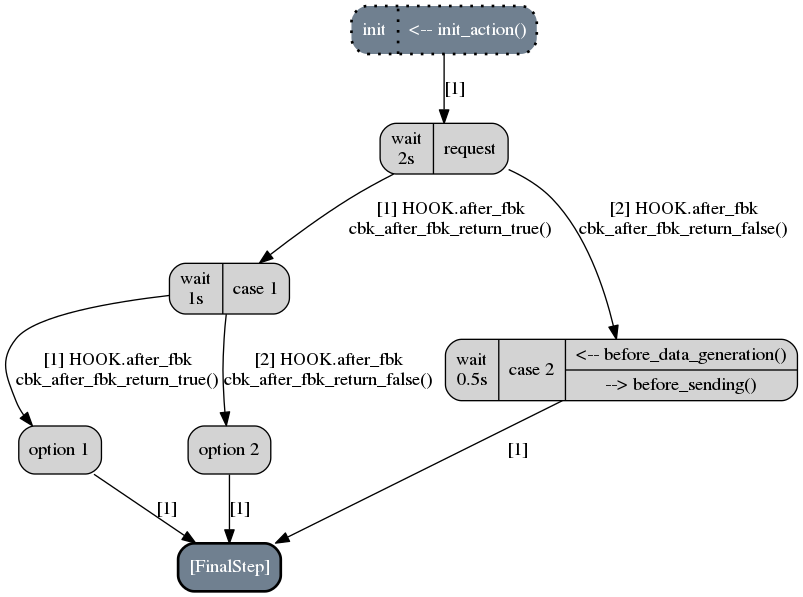
Note
It is described by the following code snippet extracted from data_models/tutorial/tuto_strategy.py:
1 init = NoDataStep(step_desc='init', do_before_data_processing=init_action)
2 request = Step(Data(Node('request', vt=UINT8(values=[1, 2, 3]))),
3 fbk_timeout=2)
4 case1 = Step(Data(Node('case 1', vt=String(values=['CASE 1']))),
5 fbk_timeout=1)
6 case2 = Step(Data(Node('case 2', vt=String(values=['CASE 2']))),
7 fbk_timeout=0.5,
8 do_before_data_processing=before_data_generation,
9 do_before_sending=before_sending)
10 final_step = FinalStep()
11 option1 = Step(Data(Node('option 1', vt=SINT16_be(values=[10,15]))))
12 option2 = Step(Data(Node('option 2', vt=UINT8(min=3, max=9))))
13
14 init.connect_to(request)
15 request.connect_to(case1, cbk_after_fbk=cbk_after_fbk_return_true)
16 request.connect_to(case2, cbk_after_fbk=cbk_after_fbk_return_false)
17 case1.connect_to(option1, cbk_after_fbk=cbk_after_fbk_return_true)
18 case1.connect_to(option2, cbk_after_fbk=cbk_after_fbk_return_false)
19 case2.connect_to(final_step)
20 option1.connect_to(final_step)
21 option2.connect_to(final_step)
22
23 reinit = Step(Data(Node('reinit', vt=String(values=['REINIT']))))
24 reinit.connect_to(init)
25
26 sc_tuto_ex4 = Scenario('ex4', anchor=init, reinit_anchor=reinit)
Note the scenario does not depends on a data model definition, because it defines itself the data to send.
6.3.2.1. Invert Transition Conditions¶
If you want to invert the transition conditions of this scenario on a step-by-step basis (meaning that each step where transitions can be inverted will trigger the generation of a scenario altering the step while the other steps will remain untouched), you can issue the following command:
[fuddly term]>> send SC_EX4(cond_fuzz=True)
And if you want to display the scenario in xdot while running through it issue the following
command instead:
[fuddly term]>> send SC_EX4(cond_fuzz=True:graph=True:graph_format=xdot)
The result will be that the following scenario—altered version of the original one—will begin to run:
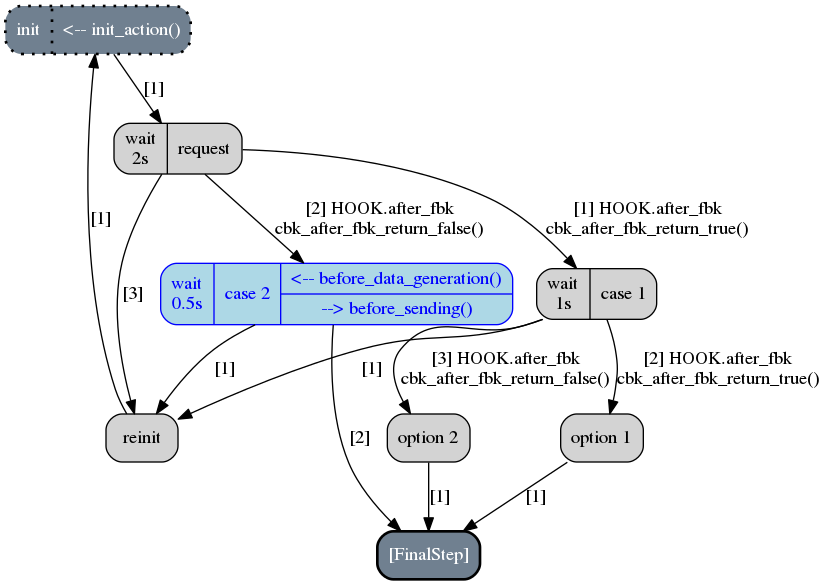
This picture represents the state of the scenario after three calls to the generator SC_EX4
(where the current step is depicted in blue). Note that the first step that has been selected by
fuddly for altering its transition is the request step (because the
sole transition of the init step is not guarded). This alteration means that the conditions that
guard the transitions of this step are inverted in order to alter the protocol logic. Practically, it
means in our example that the case 2 is chosen instead of the case 1 because the transition condition
that returns False on the original scenario, returns True in the altered one.
Note also that by default, after the alteration outcomes have been triggered (in this case after the
case 2 step has run), then a reinitialization sequence is initiated, in order to continue with the
next altered scenario case. The reinitialisation sequence is by default a simple connection
to the anchor of the scenario. But if the scenario has been provided with
a reinitialization sequence (through the reinit_anchor parameter of framework.scenario.Scenario),
this will be used instead. Our scenario example provide such reinitialization sequence
(line 23-24 of the previous code snippet) and the picture depicts the use of it (all steps that
follow the corrupted one are connected to it as well as the corrupted one in last resort if
no transition can be crossed).
But if you don’t want fuddly to perform a reinitialization after each alteration case, you simply
have to set the generator parameter reset to False. In this case, the next alteration
will trigger whenever the scenario will cross again the initial step (i.e., the scenario
anchor), but only if it cross it (which may never happen depending on the scenario).
The following picture depicts the next altered scenario that will be instantiated if we continue
to run through the generator SC_EX4 (which has been configured with the option cond_fuzz).
Note
If you want to change the parameters of the generator while it is not exhausted, you need to reset it manually by issuing the following command:
>> reset_dmaker SC_EX4
For more details refer to Resetting & Cloning Disruptors
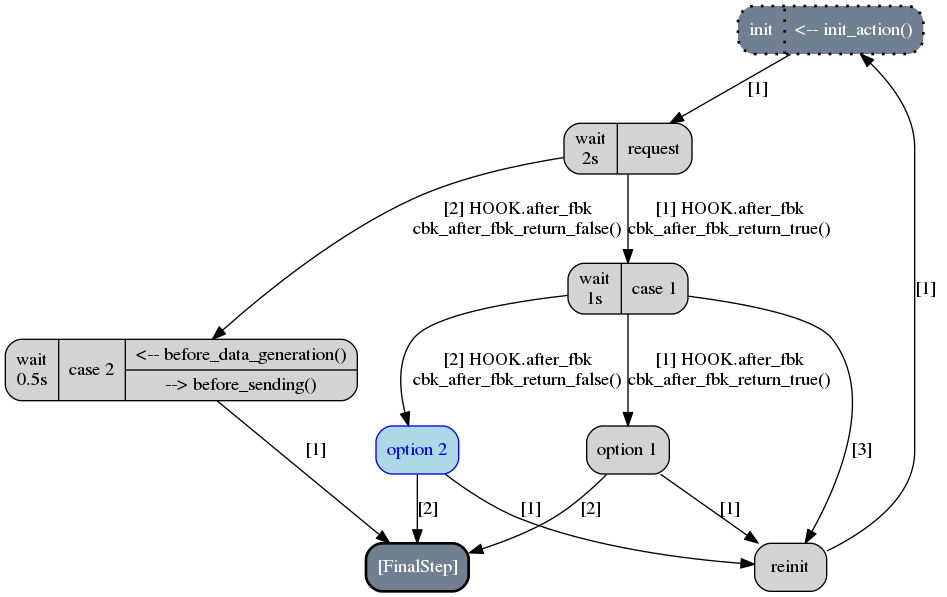
In this next altered scenario, the transition conditions of the request step are no more inverted.
Thus, we have selected the case 1 step has stated by the original scenario. But then, we choose
the option 2 step instead of the option 1 because we inverted the conditions of the
case 1 step outgoing transitions.
Note
In some cases, some altered scenario cases may not terminate depending on the
original scenario and the interaction with the evaluated target. To overcome such situation,
you can stop a scenario whenever you want and then choose the next altered scenario case manually
through the init parameter.
6.3.2.2. Ignore Timing Constraints¶
This approach follow the same pattern than (and is compatible with) the approach Invert Transition Conditions, (meaning that each step to be altered will trigger the generation of a scenario altering that step while the other steps will remain untouched). But instead of inverting the transition conditions, it generates cases that ignore timing constraints. To launch such alterations you can issue the following command:
[fuddly term]>> send SC_EX4(ignore_timing=True)
6.3.2.3. Fuzz the Data Sent by the Scenario¶
If you want to fuzz the data generated by the example scenario on a step-by-step basis, you can issue the following command
[fuddly term]>> send SC_EX4(data_fuzz=True)
This approach follow the same pattern than the approach Invert Transition Conditions (meaning that each step
to be altered will trigger the generation of a scenario altering that step while the other steps
will remain untouched).
The follwing figure depicts the third call to the generator where the scenario run through
the request step, but, contrary to the original scenario, some disruptors has been added, namely tTYPE
and tSTRUCT (refer to Generic Disruptors for more information on them). Thus, instead
of sending the correct request data, an altered version (handled firstly by tTYPE) will be sent.
The scenario will then go back to the init step by taking the reinitialization path,
in order to send the next altered
data that tTYPE can produce with the request input. This loop will continue until the tTYPE
disruptor exhausts, then the tSTRUCT disruptor will take over until exhaustion.
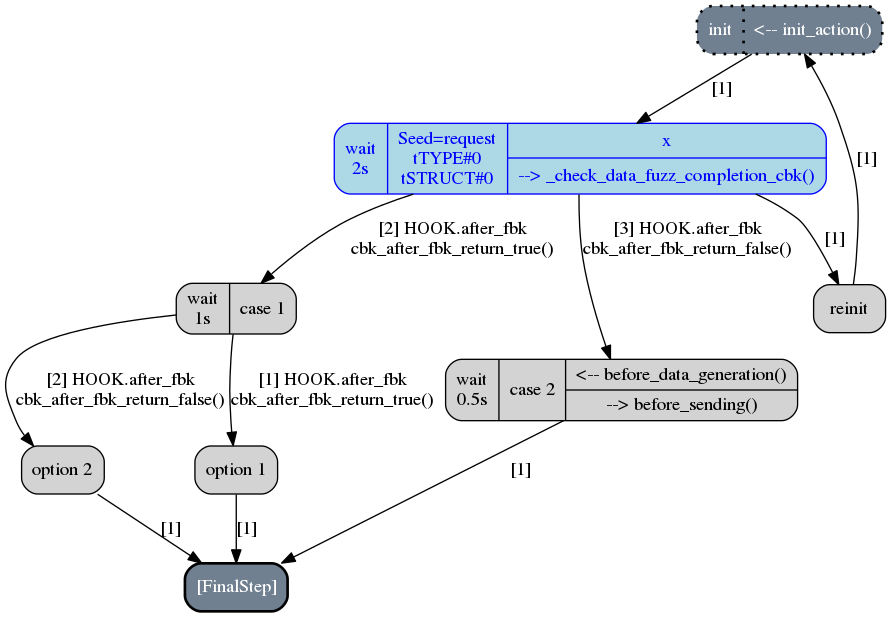
And finally, when all the alteration cases with the request step will be performed,
the next altered scenario will be created. The following picture illustrate this case:
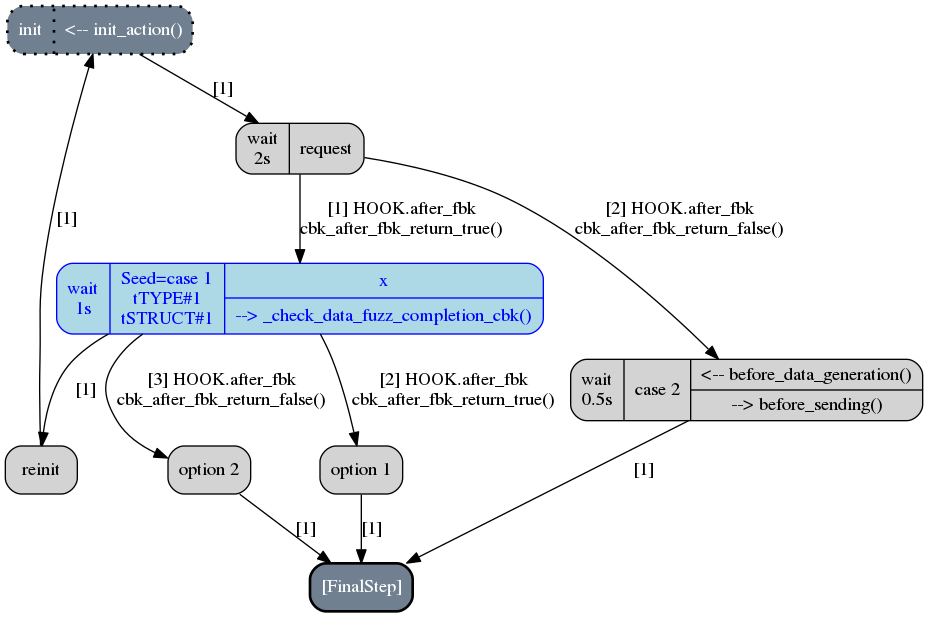
6.3.2.4. Make the protocol stutter¶
If you want to make stutter the data-sending steps of the example scenario you can issue the following command
[fuddly term]>> send SC_EX4(stutter=True)
You can also use the parameter stutter_max to specify the number of times a step have to stutter.
This approach follow the same pattern than the approach Invert Transition Conditions (meaning that each step to be altered will trigger the generation of a scenario altering that step while the other steps will remain untouched).
The following figure depicts the moment where the step which has been altered to stutter is option 1:
